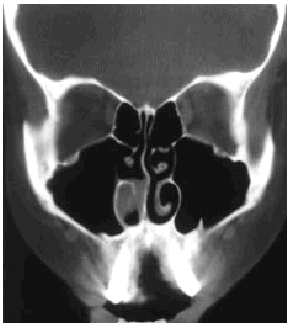INTRODUCTION
Choanal atresia is an uncommon entity, consisting of congenital blockage between the nasal cavity and the nasopharynx. The anomaly presents either immediately after birth as respiratory distress, or as a coincidental finding later in life (1, 2). Choanal atresia is frequently associated with other congenital malformations, either alone or as a polymalformation syndrome (CHARGE association: choanal atresia, coloboma, heart disease, retarded growth, genital hypoplasia, and ear anomalies). Some of these malformations may be life-threatening and consequently these patients should undergo detailed investigations to identify and treat possible malformations as soon as possible (3). Treatment is usually surgical. Approaches are transseptal, transpalatal and transantral (1, 2).
Case report
A 16-year-old girl presented with a lifelong history of right-sided nasal blockage and watery rhinorrhea. Drainage was increased by bending the head forward. The patient's symptoms were unresponsive to treatment with antihistamines and topical nasal corticosteroid sprays. Her previous medical history was unremarkable except for the expulsion of a coagulated mass through the right nostril a few days after birth. The patient's symptoms dated from that event. Physical examination was normal except for excoriation of the right external nasal margin. Anterior rhinoscopy showed watery rhinorrhea and erythematous mucosa in the right nasal cavity and deviated nasal septum. No nasal masses or polyps were found. Physical examination confirmed the absense of the right nasal airway and nasal endoscopy indicated right choanal obstruction.
Routine skin prick tests with aeroallergens were positive for grass pollen and negative for all other allergens tested (mites, moulds, latex, and epithelia). Total IgE was normal (9 IU/ml). No eosinophilia was detected in the nasal secretion specimen. Laboratory tests including complete blood count and differential, erythrocyte sedimentation rate and biochemical parameters were normal. The glucose level in the nasal discharge was 4.6 mg/dl. X-rays of the paranasal sinuses and cavum revealed no anomalies. Coronal wide-cut (5 ¥ 5 mm) computed tomography (CT) scans (fig. 1) and axial fine-cut CT scans (3 ¥ 3 mm) revealed choanal obstruction with bony and membranous components.
Figure 1.--Coronal computed tomography scan showing right coanal atresia.
DISCUSSION
Patients with nasal obstruction and rhinorrhea routinely present to the allergist for evaluation. When symptoms are unilateral, several possible diagnoses should be considered: septal deviation, septal hematoma, nasal polyposis, inverted papilloma, foreign bodies, midfacial bony lesions, midline destructive lesions, cerebrospinal fluid rhinorrhea, juvenile nasopharyngeal angiofibroma, and congenital malformations (4). Unilateral choanal atresia is occasionally seen by allergists. Most published reports are to be found in the otolaryngology literature. However, because the complications of this entity can be severe, any physician taking care of patients with rhinorrhea should include it in the differential diagnosis. Due to the non-specific nature of the symptoms, a diagnosis of choanal atresia can be overlooked for some time and patients may not seek treatment until adulthood. Clinical diagnosis is easy and should be performed at birth by the midwife or obstetrician. Traditionally, the inability to insert a soft transnasal catheter in a patient with suspected congenital choanal atresia indicates the diagnosis. In the patient reported herein, we do not know whether this procedure was carried out in the hospital maternity ward. Possibly, the catheter perforated the membranous portion with subsequent healing, which could explain the elimination of the coagulated mass. When establishing the diagnosis, flexible or rigid fiberoptic nasendoscopy with topical anesthesia allows palpation of the blockage. CT scanning indicates whether the atresia is membranous or bony, reveals the thickness, and excludes other differential diagnoses (1-5).
In conclusion, a diagnosis of unilateral congenital choanal atresia should be considered in patients with unilateral blockage and rhinorrhea. Nasal endoscopy and CT scans play an important role in establishing the diagnosis.






